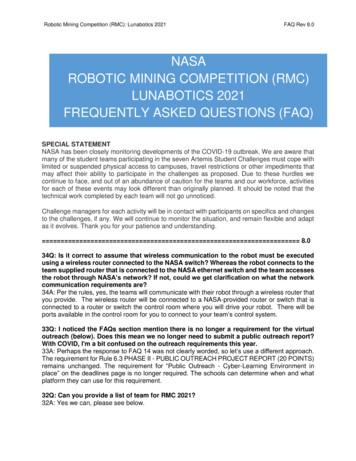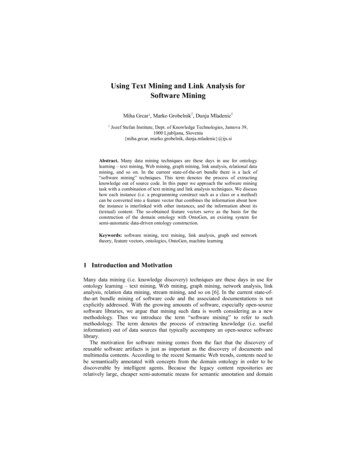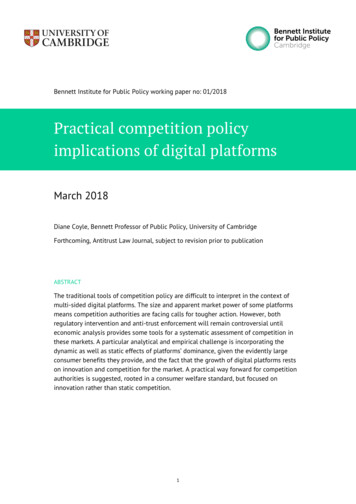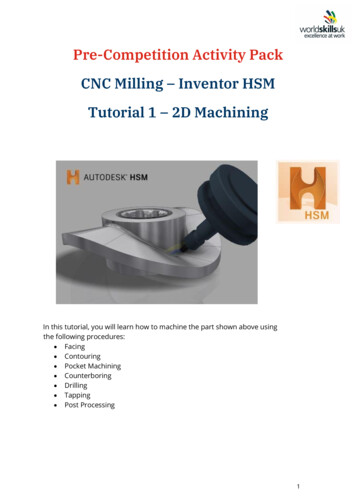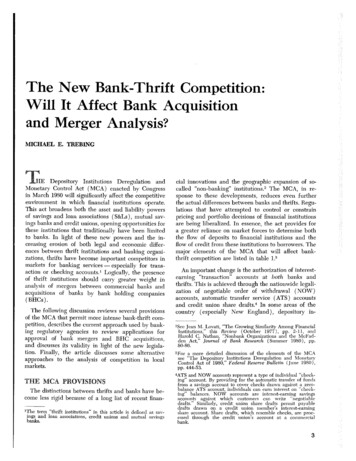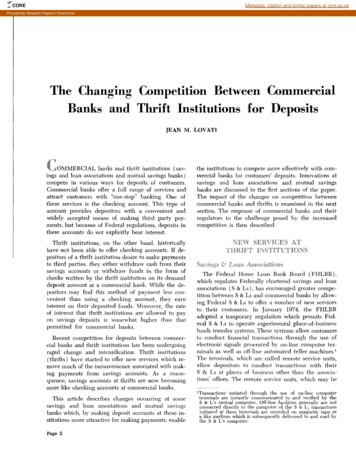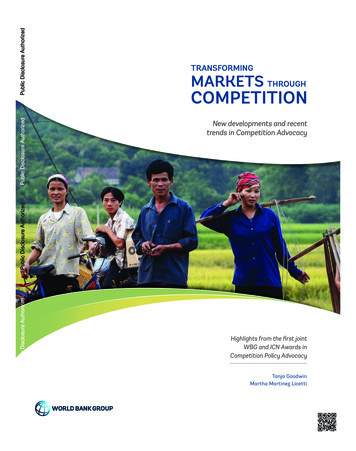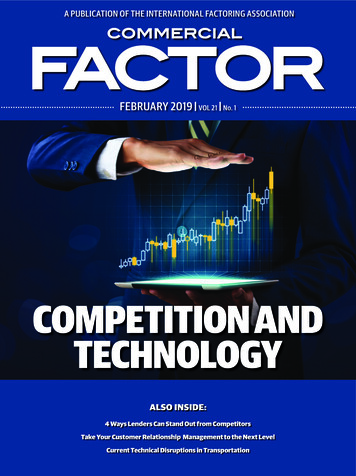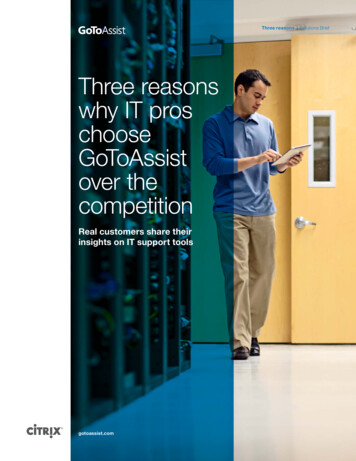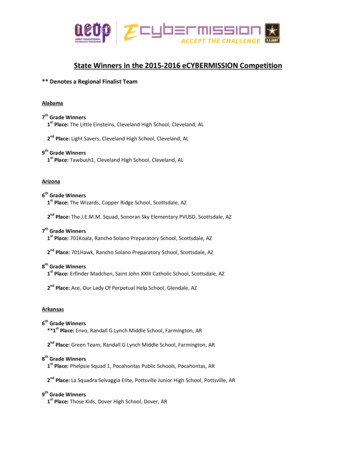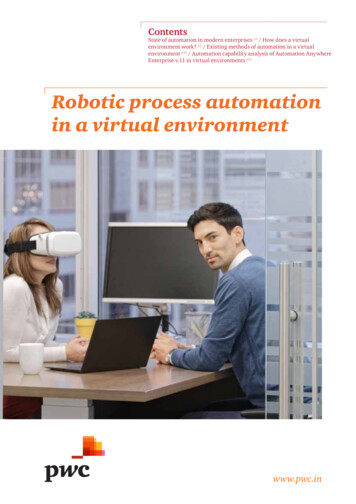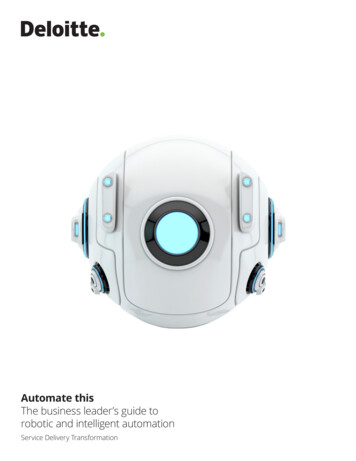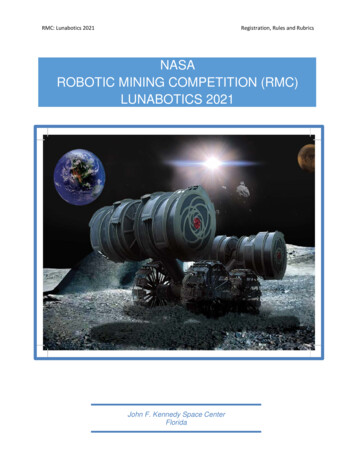
Transcription
RMC: Lunabotics 2021Registration, Rules and RubricsNASAROBOTIC MINING COMPETITION (RMC)LUNABOTICS 2021John F. Kennedy Space CenterFlorida
Registration, Rules and Rubrics Rev 1.0Robotic Mining Competition (RMC): LunaboticsSPECIAL STATEMENTNASA has been closely monitoring developments of the COVID-19 outbreak. We are aware thatmany of the student teams participating in the seven Artemis Student Challenges must cope withlimited or suspended physical access to campuses, travel restrictions or other impediments thatmay affect their ability to participate in the challenges as proposed.Due to these hurdles we continue to face, and out of an abundance of caution for the teams andour workforce, activities for each of these events may look different than originally planned. Itshould be noted that the technical work completed by each team will not go unnoticed. Challengemanagers for each activity will be in contact with participants on specifics and changes to thechallenges, if any. We will continue to monitor the situation, and remain flexible and adapt as itevolves. Thank you for your patience and understanding.NASA's Mars 2020 PerseverancePerseverance rover is in position in the aeroshell that will protect the rover on its way to the RedPlanet. To the right of the middle wheel is the plaque that commemorates the impact of theCOVID-19 pandemic and pays tribute to the perseverance of healthcare workers around theworld. Featuring a snake-entwined rod to symbolize healing and medicine, the plaque wasattached to the rover in May 2020 at Kennedy Space Center in Florida. For more informationabout the mission, go to https://mars.nasa.gov/mars2020/2
Registration, Rules and Rubrics Rev 1.0Robotic Mining Competition (RMC): LunaboticsTABLE OF CONTENTSI. INTRODUCTION1.1 THE NASA ROBOTIC MINING COMPETITION: LUNABOTICS CHALLENGE .51.2 CODE OF CONDUCT1.3 DISPUTES1.4 FREQUENTLY ASKED QUESTIONS (FAQ)1.5 CHANGES TO THE COMPETITIONII. COMPETITION DEADLINES 9III. REGISTRATION.113.1 ELIGIBILITY3.2 COLLABORATIONS3.3 TEAM REQUIREMENTS3.4 REGISTRATIONIV. COMPETITION EVENTS .134.1 RMC: LUNABOTICS4.2 PHASE I: DESIGN IT4.3 PHASE II: BUILD IT4.4 PHASE III: DIG ITV. RUBRICS FOR PHASE I .155.1 PHASE I – PLAN FOR PROJECT MANAGEMENT PLAN (10 Points)5.2 PHASE I – EXECUTIVE SUMMARY (10 Points)5.3 PHASE I – PRESENTATION (XX Points)VI. RUBRICS FOR PHASE II.196.1 PHASE II – SYSTEMS ENGINEERING PAPER (25 Points)6.2 PHASE II – SLIDE PRESENTATION AND DEMONSTRATION (25 Points)6.3 PHASE II – PUBLIC OUTREACH PROJECT REPORT (20 Points)VII. RUBRICS FOR PHASE III - MINING .277.1 THE MINING CATEGORY7.2 SCORING FOR THE MINING CATEGORY7.3 MINING POINTS – MINING7.4 MINING POINTS – COMMUNICATIONS7.5 MINING POINTS – AUTONOMYVIII. MINING COMPETITION INFORMATION – MINING ARENA PROTOCOL.368.1 LUNAR MINING ROBOT REQUIREMENTS & SAFETY8.2 MINING ARENA INFORMATION8.3 MINING PROTOCOL8.4 NAVIGATION PROTOCOL8.5 AUTONOMOUS OPERATIONS PROTOCOLIX. COMPETITION INFORMATION.449.1 SAFETY9.2 ROBOPITS PROTOCOL3
Registration, Rules and Rubrics Rev 1.0Robotic Mining Competition (RMC): LunaboticsTABLE OF CONTENTSX. COMPETITION WEEK INFORMATION .4810.1 SHIPPING YOUR ROBOT10.2 CHECK-INS/CHECK-OUTS10.3 COMPETITION WEEK GUIDE10.4 THE ROBOPITS10.5 TEST BED/SANDBOX10.6 THE BOT SHOPXI. AWARDS.51XII. GLOSSARY OF TERMS.54XIII. SUPPLEMENTAL DATA QUESTIONS .57XIV. SCORE SHEETS – ROBOT INSPECTION, MINING AND MISSION CONTROL . 634
Registration, Rules and Rubrics Rev 1.0Robotic Mining Competition (RMC): LunaboticsI. INTRODUCTION1.1 THE NASA ROBOTIC MINING COMPETITION: LUNABOTICS CHALLENGESpace Policy Directive 1On December 11, 2017, the President of the United States signed Space Policy Directive 1, achange in national space policy that provides for a U.S.-led, integrated program with private sectorpartners for a human return to the Moon, followed by missions to Mars and beyond.“NASA IS CALLED TO LAND AMERICAN ASTRONAUTS, INCLUDING THE FIRST WOMAN AND THENEXT MAN, ON THE MOON BY 2024. WE ’RE COMMITTED TO ACHIEVING THIS BOLD GOAL.THROUGH THE ARTEMIS PROGRAM, WE WILL GO TO THE MOON IN A WAY WE HAVE NEVER GONEBEFORE – WITH INNOVATIVE NEW PARTNERSHIPS , TECHNOLOGIES AND SYSTEMS TO EXPLOREMORE OF THE LUNAR SURFACE THAN EVER BEFORE. THEN WE WILL USE WHAT WE LEARN ONTHE MOON TO TAKE THE NEXT GIANT LEAP – SENDING ASTRONAUTS TO M ARS.”-NASA ADMINISTRATOR JIM BRIDENSTINEWe will collaborate with our commercial and international partners and establish sustainableexploration. Then, we will use what we learn on and around the Moon to take the next giant leap—ending astronauts to Mars. Learn more at https://www.nasa.gov/what-is-artemis.Rovers will carry a variety of instruments including ISRU experiments that will generate informationon the availability and extraction of usable resources (e.g., oxygen and water). Advancing thesetechnologies could enable the production of fuel, water, and/or oxygen from local materials, enablingsustainable surface operations with decreasing supply needs from Earth. Astronauts working on thelunar surface could test advanced robotics, as well as a wide set of new technologies identified in theLunar Surface Innovation Initiative, focusing on development in areas including in-situ resourceutilization (ISRU) and power systems.The Robotic Mining Competition (RMC): LunaboticsThis Artemis Student Challenge is designed to train university students in the methods of NASAsystems engineering while designing, building and operating an exciting lunar excavator prototype.In order to have a sustainable presence on the Moon, it will be necessary to excavate lunar regolithto extract local resources, so they don’t have to be transported from Earth, through its deep gravitywell.The excavation technology needed will require tele-operation and various levels of autonomy. Eachyear the Lunabotics RMC competitors improve the designs of their excavation robots with bettermechanical systems and improved sensors and autonomy software. Commercially availabletechnology is constantly improving and the student teams take advantage of these capabilities toincrease the level of autonomy. In addition, each year a new group of seniors enters the competitionso that there is no redundancy or duplication in student engagement. The Lunabotics RMC has acompetition model where the rules are evolving each year so that the infused technology is maximizedand the student experience is enhanced with continuous improvement. Lunabotics is a college levelevent that supports the Artemis Moon to Mars mission requiring teams to participate in multiple eventsthroughout the year and (if conditions allow) on-site at the competition. The goal of this Artemischallenge is to gather and evaluate excavator design and surface motion operational robotic data for5
Registration, Rules and Rubrics Rev 1.0Robotic Mining Competition (RMC): Lunaboticsfuture Lunar excavators.The commercial cost of delivering payloads to the Moon is about 1.2 Million per kg (2019 estimate).This competition aims to simulate a Lunar mission where a robotic excavator is delivered to the Moonfor regolith excavation operations. This corresponds to an approximate mission cost of 72 Million.Lower masses will result in lower mission costs so this competition rewards teams that have a lowerrobot mass.The complexities of this Artemis Challenge includes the Project Management Plan, an ExecutiveSummary, Vehicle Drawing(s), 3D CAD Modeling, One-Cycle Mining Animation, Public Outreach ina Cyber Learning Environment, the Systems Engineering Paper and Presenting and Demonstratingthe entirety of the team’s project and robot. The complexities of on-site mining include the abrasivecharacteristics of the regolith and icy-regolith simulants, the weight and size limitations of the Lunarmining robot and the ability to autonomously or tele-operate the robot from a remote Mission ControlCenter.TomorrowNASA will directly benefit from the competition by encouraging the development of innovative roboticexcavation concepts that may result in clever ideas and solutions. Our nation will need a future workforce that has the skills for developing autonomous robotic mining on the Moon and other off-worldlocations. Advances in off-world mining have the potential to contribute to our nation's space visionand NASA's space exploration operations. Our nation will benefit by being leaders in a new spacebased economy. The systems engineering skills are valuable in other high technology industries thatwill add to the economic strength of our country. Good for NASA, Good for America, Good for All ofUs.1.2 CODE OF CONDUCTRMC: Lunabotics is a National Aeronautics and Space Administration Artemis Challenge held in aprofessional, positive and safe environment. Competitors shall be courteous and respectful to allindividuals. Competitors shall conduct themselves with integrity as to the spirit and intent of the rulesand rubrics. Any violation of the “intent” of a rule is a violation of the rule itself. Teams (faculty advisor,students, etc.) not adhering to the Code of Conduct will be assessed penalty points. A secondviolation will result in disqualification of the team. Competitors shall use sound safety and engineeringpractices and principles at all times. Safety violations will result in disqualification of the team. TheProject Manager and Head Judge’s decision is final.1.3 DISPUTESThe scoring decisions of the judges final. If the appeal process is chosen, the faculty advisor or theteam leader shall submit the appeal in writing for consideration to the Project Manager or Head Judgein the scoring area before the last competition run of that day.1.4 FREQUENTLY ASKED QUESTIONS (FAQS)The FAQ document is revised as needed and is part of this document. It is the responsibility of theteams to read, understand, and abide by all of the Rules and Rubrics, FAQs, and any changes6
Registration, Rules and Rubrics Rev 1.0Robotic Mining Competition (RMC): Lunaboticscontained therein and to communicate with NASA’s representatives and complete all surveys. Whenemailing documents, questions, etc., please make sure that your school name (not the team name)is in the subject of all emails. Faculty Advisors and Team Leads must identify themselves whensending questions on the Rules and Rubrics to ksc-robotic-mining-competition@mail.nasa.gov1.5 CHANGES TO THE COMPETITIONThere have been changes to the competition since it was held on-site at the Kennedy Space Centerin 2018. Here are some of the changes:1. The Robotic Mining Competition (RMC): Lunabotics is now a part of NASA’s ArtemisStudent Challenges. Going forward to the Moon will be the shining moment of ourgeneration. This moment will belong to you–the Artemis generation. Are you ready? Seehttps://www.nasa.gov/stem/artemis.html2. Lunabotics strongly encourages teams to collaborate with teams from schools classifiedas Minority Serving Institutions, see COLLABORATIONS.3. When the Faculty advisor and/or Team Lead register at Team Registration, they canchoose one of the two challenges for their team. Once the choice is made, there can beno changes. Teams can choose to be in either the “Design It Challenge” or the “DesignIt, Build It, Dig It Challenge”, see RMC: LUNABOTICS CHALLENGES.4. The robotic mining arena is located inside the Astronauts Memorial Foundation’s Centerfor Space Education Building (M6-306), across the hall from the RoboPits.5. Your off-world mining robots will be smaller and lighter than before, see LUNAR MININGROBOT REQUIREMENTS & SAFETY.6. The robotic mining arenas are smaller and shallower than before, see MINING ARENAINFORMATION.7. Teams will be required to perform two official competition attempts (15 minutes each) tomine in the arena.8. All deliverables are required unless otherwise stated as optional.9. Submit all items through the website links, email submissions or copies are no longeracceptable. Do not wait until the deadline to submit.10. Faculty Advisors and Team Leads - Communicate, Communicate, Communicate - whenyou have questions, concerns, etc. We cannot respond to requests from individual teammembers.11. In the event the on-site mining competition cannot be held, the winners of the “Design It,Build It, Dig It Challenge” will be based on the teams with the highest total score fromPhase I plus Phase II combined.12. Statement of Rights of UseThese two statements grant NASA, acting on behalf of the U.S. Government, rights touse the team’s technical data and design concept, in part or in entirety, for government7
Registration, Rules and Rubrics Rev 1.0Robotic Mining Competition (RMC): Lunaboticspurposes. This statement is not required. If choosing to include these statements, ALLteam members and faculty advisors must sign. The statements read as follows:As a team member for “ ” a team of undergraduate/graduatestudents from university/college, I will and hereby do grant the U.S.Government a royalty-free, nonexclusive and irrevocable license to use,reproduce, distribute (including distribution by transmission) to the public,perform publicly, prepare derivative works, and display publicly, any datacontained in this proposal in whole or in part and in any manner for Federalpurposes and to have or permit others to do so for Federal purposes only.As a team member for “ ” proposed by a team ofundergraduate/graduate students from university/college, I will andhereby do grant the U.S. Government a nonexclusive, nontransferable,irrevocable, paid-up license to practice or have practiced for or on behalf of theUnited States an invention described or made part of this proposal throughoutthe world.The Indoor Mining Arena8
Registration, Rules and Rubrics Rev 1.0Robotic Mining Competition (RMC): LunaboticsII. COMPETITION DEADLINESAll items are due by 12:00 p.m. noon Eastern Time on the date listed below, failure to meet thedeadlines will result in disqualification from the competition.DeadlinesRegistration1Rules and Rubrics ReleasedTue Aug 11, 20202Team Registration OpensWed Aug 19, 2020Labor Day (Federal Holiday)Mon Sep 07, 2020Team Registration ClosesWed Sep 16, 20203Lunabotics Phase I - Design It1234Submit Project Management Plan (required toadvance to Phase II)Phase I Only Teams – Submit Team Biography andPhoto w/FacultyColumbus Day (Federal Holiday)Wed Sep 30, 2020Wed Sep 30, 2020Mon Oct 12, 2020Submit Executive SummaryWed Oct 28, 2020Veterans Day (Federal Holiday)Wed Nov 11, 2020Thanksgivings Day (Federal Holiday)Thu Nov 26, 2020Phase II Teams AnnouncedDec 2020Lunabotics Phase II - Build It (Jan-Apr)123456New Year's Day (Federal Holiday)Public Outreach - Cyber-Learning Environment inplace.Martin Luther King Day (Federal Holiday)Fri Jan 01, 2021Wed Jan 13, 2021Mon Jan 18, 2021President's Day (Federal Holiday)Submit Team Roster, Student Resume, TeamBiography, Team Photo and Corrections to the NASAgenerated Team RosterSubmit Final Team RosterMon Feb 15, 2021Submit Systems Engineering PaperSubmit Proof of Life - YouTube link, Submit RobotPhoto (min. 1024 x 768 JPEG), SubmitSupplementary Robot Data in Google DocsSubmit Slide Presentation and DemonstrationWed Apr 07, 20219Wed Mar 03, 2021Mon Mar 29, 2021Fri Apr 16, 2021
Registration, Rules and Rubrics Rev 1.0Robotic Mining Competition (RMC): Lunabotics7Submit Public Outreach Project ReportLunabotics Phase III - Dig It (May)1Robot Vehicle and Communications Inspection2Robot Practice DaysMon-Tue May 17-183Teams Present and DemonstrationTues-Fri May 18-214Opening CeremonyTue May 185Robotic Mining DaysWed-Fri May 19-216Women in STEM Forum KSCVC Debus Center7Awards Ceremony KSCVC Apollo-Saturn V Center10Mon May 17Wed May 19Fri May 21
Registration, Rules and Rubrics Rev 1.0Robotic Mining Competition (RMC): LunaboticsIII. REGISTRATION3.1 ELIGIBILITYSchools (post high school, vocational/technical schools, colleges and universities) located inthe United States, its Commonwealths, territories and/or possessions are eligible to registerfor the Lunabotics competition. Collaborating schools must register is the same manner at theprimary school they are collaborating with for the competition.3.2 COLLABORATIONSNASA collaborates with space agencies around the globe on many programs including theInternational Space Station, Earth observation missions and those headed to the Moon or Marsand other off-world destinations. Building and nurturing an eligible, diverse and inclusiveworkforce is imperative to the future success of NASA and to our Nation. Lunabotics stronglyencourages registered teams to collaborate with teams (virtually, until conditions change) fromschools classified as Minority Serving Institutions, vocational/technical schools, communitycolleges, etc. As an example, awards to winning collaborating teams would read as follows:“Mars University” in collaboration with “Bending State University”Decades of research by organizational scientists, psychologists, sociologists, economists anddemographers show that socially diverse groups (that is, those with a diversity of age, race,ethnicity, gender and sexual orientation) are more innovative than homogeneous groups (seeScientific American, dated 10.01.2014).1.2.3.4.MSI Capability Gatewayhttps://msigateway.larc.nasa.gov/Minority Serving Institutions institutions-program.Eligible edlite-minorityinst-list-tab.htmlScientific /how-diversity-makes-us-smarter/3.3 TEAM REQUIREMENTS1.2.3.4.5.6.Students can be members of only one team.Each team must have its own working robot(s).Faculty advisor/staff/team lead must be registered with the school.Team members must be cleared by NASA Security to attend this event.Students must be currently enrolled and in good standing with the school.The size of the team is at the discretion of the school, but the team must include at least twoundergraduate students and no Ph.D. students.11
Registration, Rules and Rubrics Rev 1.0Robotic Mining Competition (RMC): Lunabotics3.4 REGISTRATIONRegistration for Lunabotics is automated and electronically monitored. All teams must registervia the site(s) provided and comply with all deadlines.1. The Faculty Advisor or the assigned Team Lead will go to:www.secorstrategies.com/2021teamlunabotics to start the team registrationprocess.2. Teams can choose to participate in one of the two challenges for their team. Atregistration, teams must choose to compete in one of two challenges.“Design It Challenge” (Phase I) OR “Design It, Build It, Dig It Challenge” (Phase I, Phase II, Phase III)If a team chooses this challenge, the 50 highest scoringteams from Phase I “Design It” (and not the “Design ItChallenge”) will be invited to the Phase II “Build It”challenge. Teams successfully completing all Phase II“Build It” requirements will be invited to the Phase III “DigIt” on-site challenge at the Kennedy Space Center inFlorida
The complexities of this Artemis Challengeincludes the Project Management Planan Executive , Summary, Vehicle Drawing()s, 3D CAD M odeling, One-Cycle Mining Animation, Public Outreach in a Cyber Learning Environment, the Systems Engineering Paper and Presenting and Demonstrating the
